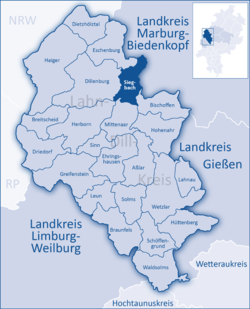Siegbach
| Siegbach | ||
|---|---|---|
|
||
| Coordinates: 50°44′N 08°25′E / 50.733°N 8.417°ECoordinates: 50°44′N 08°25′E / 50.733°N 8.417°E | ||
| Country | Germany | |
| State | Hesse | |
| Admin. region | Gießen | |
| District | Lahn-Dill-Kreis | |
| Government | ||
| • Mayor | Bernd Happel | |
| Area | ||
| • Total | 29.08 km2 (11.23 sq mi) | |
| Elevation | 350 m (1,150 ft) | |
| Population (2015-12-31) | ||
| • Total | 2,643 | |
| • Density | 91/km2 (240/sq mi) | |
| Time zone | CET/CEST (UTC+1/+2) | |
| Postal codes | 35768 | |
| Dialling codes | 02778 | |
| Vehicle registration | LDK | |
| Website | www.siegbach.de | |
Siegbach is a community in the Lahn-Dill-Kreis in Hesse, Germany.
The community of Siegbach lies in the Lahn-Dill Highland in the valley of its namesake brook, the Siegbach, which empties into the Aar to the south at Bischoffen.
More than half of the municipal area is wooded.
Siegbach borders in the north on the communities of Eschenburg (Lahn-Dill-Kreis) and Angelburg, in the south on the communities of Bischoffen and Mittenaar, in the southwest on the town of Herborn, and in the west on the town of Dillenburg (all in the Lahn-Dill-Kreis).
The community consists of the five centres of Eisemroth (administrative seat), Oberndorf, Tringenstein, Übernthal and Wallenfels.
As part of Hesse's municipal reforms, the formerly independent municipalities of Eisemroth, Tringenstein, Übernthal and Wallenfels merged on 1 January 1972 to form the greater community of Siegbach, after the communities of Oberndorf and Eisemroth had already been united for a year. The new community's namesake is the brook in whose valley the greater part of the community lies.
Within the municipal area once stood three castles, namely in Eisemroth (on whose site a church now stands), Wallenfels and Tringenstein. They came into being during the "Hundred Years' Dernbacher Feud", which was hard-fought in this area. It was a struggle waged between 1233 and 1333 between the Lords of Dernbach and the ambitious Counts of Nassau, who eventually won.
Siegbach's civic coat of arms might heraldically be described thus: In vert on ground Or a mine gallery sable with framework Or, therein, a crossed hammer and pick (the traditional mining tools or Gezähe) argent.
The arms refer to the municipal area's former mining industry.
The Wilhelmsteine ("William's Stones"), lying between Tringenstein and Wallenfels, are a group of pyrite monadnocks in the middle of the Schelderwald (a foothill of the Rothaargebirge range). Every year on Ascension Day, the Wilhelmsteine serve as a local pilgrimage place. A religious service is performed among them on this day.
...
Wikipedia



